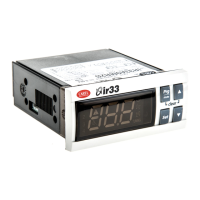the same. In Z version relay 3 is activated for general alarms and for lower limit alarm,
whereas relay 4 is activated for general alarms and for higher limit alarm.The alarm relay
activation is added to the other alarm signals, active with other function modes that are
alarm code on display and acoustic warning (in buzzer equipped versions). In W and Z
versions, the relays which are not used for the alarm signal can be used as in Mode 3.
Once activated, the alarm output will go back to the OFF position when the cause of the
alarm ends (“automatic resetting”, is obtained with a “low” value selected for the alarm
differential P27) or when the PRG-MUTE key is being pressed (with manual resetting, is
obtained by selecting “high” values for P27). It is important to point out that if the MUTE key
is pressed when the cause of the alarm is still present, the buzzer will be silenced but the
alarm code and the alarm relay will remain active.
Mode 6: Direct / Reverse selection from digital input (pict. 10).
The main parameters in this kind of function are Set Point (St1), Direct mode differential
(P1), Set Point (St2) and Reverse mode differential (P2).The instrument selects Direct or
Reverse function (see Mode 1 and Mode 2) according to the condition of the digital input 1.
More precisely you will have: Direct function when digital input 1 is open and Reverse
function when digital input 1 is closed.
Mode 7: Direct function mode with selection of Set and differential from digital
input (pict. 11).
With this kind of function the condition of the digital input (open/closed) does not change
the kind of action (always Direct), but changes Set Point and differential.The main
parameters in this kind of function are active Set (St1) and differential (P1) with open digital
input and active Set (St2) and differential (P2) with closed digital input.
47
Advanced set-up: Function Modes description
+05-3015 • rel.3.0 interno ok 18-09-2002 14:31 Pagina 47

